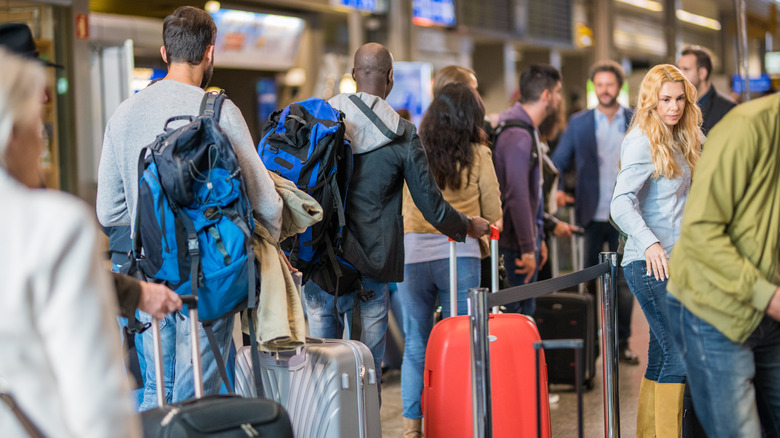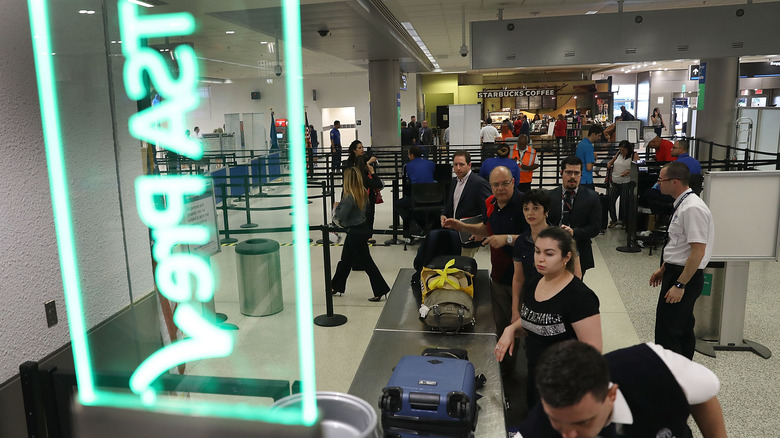How To Tell If TSA PreCheck Or Global Entry Is Best For You
It's about the journey and not the destination. This may apply to some things in your life, but not as much to literal destinations, especially if you're flying there. Even if you have packing hacks in place for your family to go through TSA with as few problems as possible, going through airport security can still be a hassle. To expedite getting through a busy airport, you may want to consider signing up for TSA PreCheck or Global Entry. They're both options in the Trusted Traveler Platforms put in place by the Department of Homeland Security (DHS) that confirm that you are who you say you are and that you don't pose a security threat.
There are some significant differences between the two in terms of what they can get you. Assuming that you're a U.S. citizen, deciding on which one to get in large part comes down to whether or not you're a frequent international traveler — if you are, go for Global Entry. If not, look into TSA PreCheck. Here's why.
Global Entry makes it easier to get into the U.S.
The main benefit to Global Entry is getting into the U.S. via a shorter line and without having to fill out customs paperwork or talk to a customs worker upon entering the country. It's available for U.S. citizens and permanent residents, as well as over a dozen other countries. Depending on the country, you may have to have a specific visa to be eligible, but broadly speaking, you have to prove you're a low-risk traveler, including no criminal convictions. Global Entry is not available at every U.S. airport, but it's at some of America's biggest and most frequented, including the world's busiest airport, as well as some international locations.
The initial online application costs $100 — check your eligibility before applying because the application fee is non-refundable. Then you have to go through an in-person screening interview, which involves getting fingerprinted and biometric measurements of your face. The processing time for Global Entry can be measured in months, so plan ahead if you've got international trips coming up. Once you get approved, Global Entry lasts for five years. If you don't travel internationally very often, you might think it's not worth it. But one big bonus to Global Entry is that it also comes with TSA PreCheck. So, depending on your travel plans, if you already have TSA PreCheck, you might want to hold off on getting Global Entry until your PreCheck is near its expiration.
TSA PreCheck is cheaper and quicker to get
If you're not a frequent international traveler, TSA PreCheck by itself may be the better option. It's available at over 200 airports in the U.S., and it gives you access to shorter security lines. While you'll enjoy some perks like keeping your shoes on, there are some things that are exempt from the TSA 311 liquid rule. Having PreCheck doesn't make you exempt from following the liquid limits in general — just that you don't have to take them out of your bag before it goes through the X-ray machine. Like Global Entry, you have to fill out an application and arrange for an in-person interview where you'll be fingerprinted to get approved, and PreCheck status lasts for five years. It costs around $80, depending on which approved provider you use, and it's only available to U.S. citizens and permanent residents.
One major difference between PreCheck and Global Entry, beyond the international travel aspect, is how long it takes to process your application. After your TSA PreCheck screening, it may be within just a week that you get your Known Traveler Number (KTN) — which you need to use when you book your ticket to get TSA PreCheck privileges — not the months that it takes for Global Entry. However, even with Global Entry and TSA PreCheck, you could still get randomly assigned the dreaded "SSSS" on your boarding pass, which means you'll have to go through some extra airport security for that flight.


